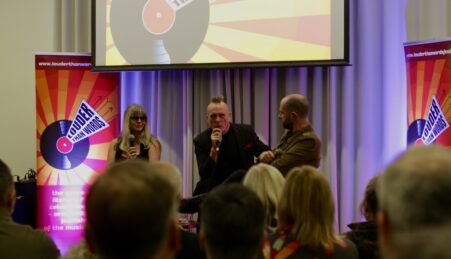
Humanity Hallows Issue 6 Out Now
Pick up your copy on campus or read online
By Pierangelly Del Rio Martinez
Manchester Metropolitan University’s Humanities in Public Festival, in association with The Modernist Society, presented the Manchester Modernist GM10 Part One, a tour of five boroughs across the Greater Manchester area exploring the architecture of a select group of 20th-century buildings.
Speaking about the event, Humanities in Public Coordinator Helen Darby said: “There are two events one month apart, across ten Manchester boroughs, the ten boroughs that make up the Greater Manchester Combined Authority. This whole year was about thinking about that in terms of Northern Identity and what it means to be part of a collective identity across the whole Greater Manchester.We’re headed to five of those boroughs this time to look at our favourite examples of modernist architecture.”
Helen also explained that the event intended to involve the public as they are invited to discuss which building is best: “We ask people on the website to vote for and nominate the top ones.”
Attendees gathered in front of Manchester School of Art before boarding a bus to take them to the different destinations. The first stop was Swinton, which now forms part of the wider metropolitan borough of Salford. Swinton is the home of the Salford City Council’s main administrative office and the Civic Central, buildings that both have noteworthy architecture.
Public Speaker at the Manchester Modernist Society Eddy Rhead commented: “Swinton was its own borough. Swinton and Pendlebury, in 1974, were brought together and Swinton was brought into Salford and it sort of coincided with Salford, destroying the heart of Salford which is down Regent Road and Broad Street. Regent Road was the main shopping Street, and that was all prefigured and Salford kind of lost its civic heart.”
After admiring the Civic Centre, the group crossed Chorley Road, towards the Lancastrian Hall. Designed by the Manchester based Leach, Rhodes and Walker, the building once acted as a centre for arts and leisure with an attached library. Currently, the hall, described by Rhead as a building with aspects of postmodern and brutalist architecture, is empty, and its structure is slowly deteriorating as a result of poor management at the hands of Salford City Council.
Next was Wigan, which is home to the Turnpike Centre. The Turnpike echoes the post-war period, being an architecturally innovative modernist building combined with an open library and a gallery on the upper floor. What is perhaps one of this building’s most striking features is the mural on its front, a large, abstract concrete relief created by the industrial designer William Mitchell. Most recently, the Turnpike has used the upper floor as an independent art gallery which continues to be adapted for future installations.
Almost nine miles away, the tour reached Bolton. It was pointed out that Bolton has little to offer those seeking decent post-war architecture; however, the borough is characterized by a remarkable mix of periods and styles that are found in northern industrial towns. Attendees had the opportunity to walk freely around the city centre and to enjoy lunch in the many restaurants and coffee shops the town has to offer. Most remarkable about the area was the town hall and Le Mans Crescent, an inter-war composition by the local firm of Bradshaw, Gass and Hope.
Similar to Bolton, Bury, the next stop, has little to entice the Modernist movement, due to successive town councils having contributed to destroying any sense of an attractive town centre. Nevertheless, the tour stopped in the very remarkable Market Hall from 1971. In common with other market halls from the period, a clear open span was the goal, to maximise trading floor space. This achievement, however, is difficult to appreciate in Bury, with subsequent additions obstructing what is an impressive space. On a Saturday afternoon, the market was a busy space, filled with stands and shoppers, clearly making the place one of the most lively in the area.
The tour ended at Queen Elizabeth Hall in Oldham. Characterised by its city centre architecture, Oldham possesses a dominant post-war sense. Queen Elizabeth Hall is one of these buildings, which is essentially a concrete block with a striking sculptural front piece resembling massive organ pipes. Besides being aesthetically pleasing, the hall serves as a multi-purpose venue.
In the middle of a grey afternoon, the first part of the Manchester Modernist Tour came to an end. Attendees did not only get to admire the striking and often hidden structures across the North but also get a taste of the history behind them. They also had the opportunity to join in a conversation about what they had seen.
The next part of the Manchester Modernist programme will be hosted on the 24th of June and will explore the remaining Greater Manchester Boroughs.






Leave a reply